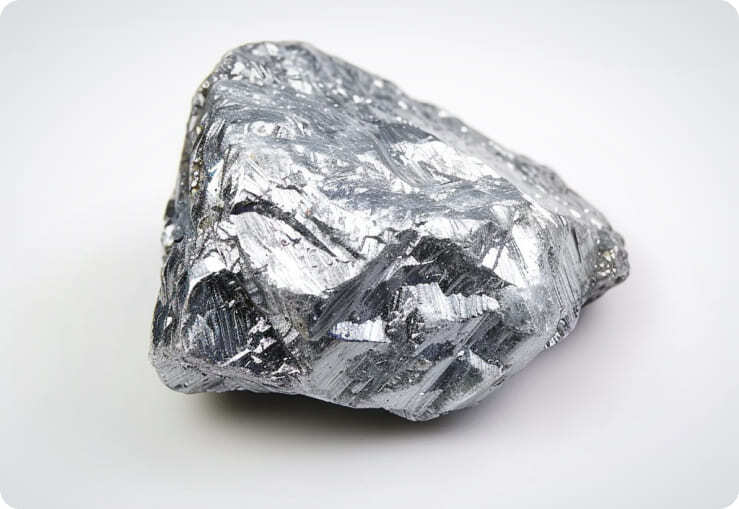
Molybdenum
Country of origin:
uzbekistan
production cycle:
- Production of molybdenum trioxide, sieving
- I reduction (production of MoO2), sieving
- II reduction (production of metallic Mo), sieving
- Preparation of the plasticizer
- Homogenization and moistening of the metallic molybdenum powder
- Briquetting
- Sintering of briquettes
- Quality control of the finished product
Application:
Aerospace. In the aerospace, it is utilized for the outer layers of supersonic aircraft, as well as for constructing the frontal sections of these vehicles. Molybdenum or its alloys may act as the primary structural material or as a thermal barrier.
Metallurgy. Within the field of ferrous metallurgy, molybdenum enhances steel’s ability to be hardened, its durability, resistance to corrosion, and toughness. Alloys containing molybdenum are crafted into vital components and machinery parts. Furthermore, molybdenum’s role extends to improving the properties of cobalt and chromium alloys, making them suitable for parts with wear-resistant edges. It’s also a component in durable alloys resistant to acid, made with chromium, nickel, and cobalt.
Given its high melting point, molybdenum is crucial in producing tools for the hot working of steel and is also fashioned into rods used in the die-casting of various metal alloys.
Chemical manufacturing. In the realm of chemical manufacturing, equipment that operates within acidic conditions is made from molybdenum. It’s also fashioned into heating elements for hydrogen atmosphere furnaces. Several molybdenum compounds are pivotal as catalysts in chemical reactions, and they’re included in the composition of certain glazes and pigments.
Glassmaking. In glassmaking, molybdenum’s resistance to molten glass makes it invaluable for glass melting processes and in crafting electrodes.
Electronics and radiography. The electronics and radiography sectors utilize molybdenum for constructing vacuum device components, including X-ray tubes and electronic lamps.
Metallurgy. Within the field of ferrous metallurgy, molybdenum enhances steel’s ability to be hardened, its durability, resistance to corrosion, and toughness. Alloys containing molybdenum are crafted into vital components and machinery parts. Furthermore, molybdenum’s role extends to improving the properties of cobalt and chromium alloys, making them suitable for parts with wear-resistant edges. It’s also a component in durable alloys resistant to acid, made with chromium, nickel, and cobalt.
Given its high melting point, molybdenum is crucial in producing tools for the hot working of steel and is also fashioned into rods used in the die-casting of various metal alloys.
Chemical manufacturing. In the realm of chemical manufacturing, equipment that operates within acidic conditions is made from molybdenum. It’s also fashioned into heating elements for hydrogen atmosphere furnaces. Several molybdenum compounds are pivotal as catalysts in chemical reactions, and they’re included in the composition of certain glazes and pigments.
Glassmaking. In glassmaking, molybdenum’s resistance to molten glass makes it invaluable for glass melting processes and in crafting electrodes.
Electronics and radiography. The electronics and radiography sectors utilize molybdenum for constructing vacuum device components, including X-ray tubes and electronic lamps.
grades:
1, 2
Content of the main substance (molybdenum), not less than %
1
97,692
97,062
№
Grade 2
Indicator's name
Standard
Grade 1
Impurity content, no more than %
2
Silicon dioxide
1,5
1,5
Molybdenum
0,3
0,3
Oxygen (and moisture)
1,0
1,0
Carbon
0,1
0,1
Phosphorus
0,01
0,01
Sulfur
0,01
0,01
Copper
0,01
0,01
Arsenic
0,01
0,01
Tin
0,003
0,003
Antimony
0,003
The product information provided here is indicative and is subject to confirmation at the time the order is processed.
0,003
Lead
0,003
0,003
Bismuth
0,003
0,003
Zinc
0,006
0,006
Nickel
0,1
0,1
Iron
-
0,5
Briquette weight, kg
0,02÷2,6
0,02÷2,6
